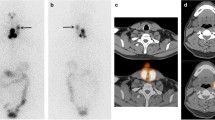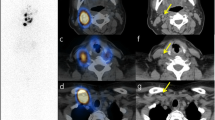Abstract
Purpose
The purpose of the study was to determine the diagnostic impact of 131I-SPECT/CT imaging compared with conventional scintigraphic evaluation in the follow-up of patients with thyroid carcinoma.
Methods
Seventy-one patients with thyroid carcinoma underwent concurrent 131I-SPECT/CT, using an integrated imaging system, at various stages of their disease in order to evaluate foci of uptake detected on planar whole-body images.
Results
SPECT/CT imaging had an incremental diagnostic value in 57% (41/71) of patients. Uptake in the neck was evaluated in 61 patients, and SPECT/CT imaging in this region had an incremental diagnostic value in 27% of the whole patient population (19/71). Low-resolution integrated CT images allowed for the precise characterization of equivocal neck lesions on planar imaging in 14/17 patients and changed the assessment of the lesion location in five patients as compared with planar studies. Thirty-six patients underwent SPECT/CT for evaluation of foci of uptake distant from the neck. SPECT/CT imaging improved characterization of equivocal foci of uptake as definitely benign in 13% (9/71) of patients. Precise localization of malignant lesions to the skeleton was possible in 17% (12/71) and to the lungs versus the mediastinum in 6% (5/71) of patients.
Conclusion
Integrated 131I-SPECT/CT was found to have an additional value over planar imaging in patients with thyroid cancer for correct characterization of equivocal tracer uptake seen on planar imaging as well as for precise localization of malignant lesions in the neck, chest, and skeleton. SPECT/CT optimized the localization of 131I uptake to lymph node metastases versus remnant thyroid tissue, to lung versus mediastinal metastases, and to the skeleton. It also had a further clinical impact on patient management by influencing referral for 131I treatment, tailoring of the administered radioiodine dose, and/or the addition of surgery or external radiation therapy when indicated.





Similar content being viewed by others
References
Mazzaferi EL. Recombinant human thyrotropin symposium: an overview of the management of papillary and follicular thyroid carcinoma. Thyroid 1999;9:421–9
Unal S, Menda Y, Adalet I, et al. Thallium-201, technetium-99m-tetrofosmin and iodine-131 in detecting differentiated thyroid carcinoma metastases. J Nucl Med 1998;39:1897–902
Lubin E, Mechlis-Frish S, Zats S, et al. Serum thyroglobulin and iodine-131 whole body scan in the diagnosis and assessment of treatment for metastatic differentiated thyroid carcinoma. J Nucl Med 1994;35:257–62
Scott AM, Mcapinlac H, Zhang J, et al. Image registration of SPECT and CT images using an external fiduciary band and three-dimensional surface fitting in metastatic thyroid cancer. J Nucl Med 1995;36:100–3
Bocher M, Balan A, Krauz Y, et al. Gamma camera-mounted anatomical X-ray tomography: technology, system characteristics and first images. Eur J Nucl Med 2000;27:619–27
Patton JA, Delbeke D, Sandler MP. Image fusion using an integrated dual-head coincidence camera with X-ray tube based attenuation maps. J Nucl Med 2000;41:1364–8
Even-Sapir E, Keidar Z, Sachs J, et al. The new technology of combined transmission and emission tomography in evaluation of endocrine neoplasms. J Nucl Med 2001;42:998–1004
Yamamoto Y, Nishiyama Y, Monden T, et al. Clinical usefulness of fusion images of I-131 SPECT and CT in patients with differentiated thyroid carcinoma. J Nucl Med 2002;43:321P [abstract]
Kienast O, Becherer A, Dobroemsky G, et al. Improved diagnostic accuracy of I-131 WBS in patients with thyroid cancer using fusion technology with combined XCT/SPECT-imaging. Eur J Nucl Med Mol Imaging 2002;29:374 [abstract]
Bernier MO, Leenhardt L, Hoang C, et al. Survival and therapeutic modalities in patients with bone metastases of differentiated thyroid carcinomas. J Clin Endocrinol Metab 2001;86:1568–73
Shapiro B, Rufini V, Jarwan A, et al. Artifacts, anatomical and physiological variants, and unrelated diseases that may cause false-positive whole-body 131-I scans in patients with thyroid cancer. Semin Nucl Med 2000;30:115–32
Wilson LM, Barrington SF, Morrison ID, et al. Therapeutic implications of thymic uptake of radioiodine in thyroid carcinoma. Eur J Nucl Med 1998;25:622–8
Michigishi T, Mizukami Y, Shuke N, et al. Visualization of the thymus with therapeutic doses of radioiodine in patients with thyroid cancer. Eur J Nucl Med 1993;20:75–9
Author information
Authors and Affiliations
Corresponding author
Rights and permissions
About this article
Cite this article
Tharp, K., Israel, O., Hausmann, J. et al. Impact of 131I-SPECT/CT images obtained with an integrated system in the follow-up of patients with thyroid carcinoma. Eur J Nucl Med Mol Imaging 31, 1435–1442 (2004). https://doi.org/10.1007/s00259-004-1565-2
Received:
Accepted:
Published:
Issue Date:
DOI: https://doi.org/10.1007/s00259-004-1565-2




